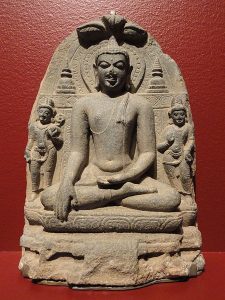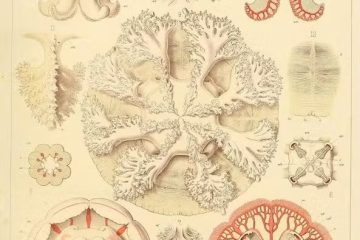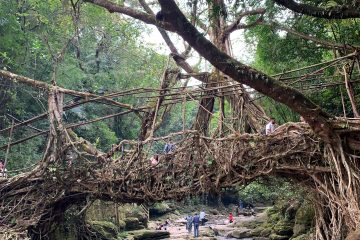Creatures of a Common Home: Finding Our Way to Planetary Solidarity

“Maybe when the aliens show up it will finally happen,” I said to my son. “What will happen?” he inquired. “A sense that we are all earthlings, children of the same planetary mother.”
Some sense of fidelity to the world is a desperate necessity in these days of global climate change, mass extinction, and pandemic—threats that are neither merely national nor local even if they do take distinctive local inflections. Yet, human communities remain disturbingly provincial as a raft of nationalistic populisms are dividing us into self-absorbed interest groups. On one hand, waiting for extraterrestrials to show up to generate planetary solidarity is a dangerous contingency plan. But on the other, hoping for such solidarity to emerge in some less cinematic fashion, from humanity itself, appears more fanciful than sci-fi fantasy.
You would think that a pandemic would do the trick—demonstrate unambiguously that we are inseparably bound together by networks of commerce, trade, travel and, yes, viral flows, even across species divides. Yet, vaccine hoarding by wealthy nations continues in the global North while Latin America and India suffer catastrophic case numbers and unprecedented mass death. Even as vaccines are inequitably distributed, COVID variants from Brazil and elsewhere make their way North, a dangerous witness to world-wide transmission patterns and proof that narrow national self-interest is ultimately self-defeating.
Is planetary belonging, even in the middle of a pandemic, too thin a notion, an identity too wan to command devotion and service? Does robust belonging require an enemy, an outside “them” against which “we,” on the inside, can define ourselves? Might there be some other way of generating planetary fidelity–of seeing ourselves as common creatures of a shared earth—other than alien arrival? Might religious traditions cultivate a loyalty to other persons and earth rather than to otherworldly afterlives and rapturous escapes?
But, first, what about those virulent populist nationalisms—how are they faring? Arguably, nationalisms have offered the thickest (and deadliest) form of belonging over the last two centuries, populism being but its latest incarnation. Yet countries whose leaders have given themselves over most vigorously to chest-thumping nationalism have been the hardest hit by the pandemic and sorely humbled. As Uri Friedman, contributing writer at The Atlantic, shrewdly observes, “If the way out of the pandemic is through science, in the form of mass vaccination and other containment measures, the corollary is also true: The way we remain mired in it is, in large part, through the kind of anti-science worldview that populists frequently champion.” Friedman shows that even as populisms are mobilized to muster majoritarian national loyalties, they pose a threat not only to their own people but also to global health as a whole.
We need only call to mind the U.S. under Trump (500,000), Brazil under Bolsonaro (425,000), and India under Modi (250,000)—the last two tallies rapidly rising. The scenes from India are especially heartrending: now over 4000 are dying each day, with even that number likely to be a severe undercount. Given such horrific losses, what does it matter that Modi once claimed to have a 56-inch chest? Perhaps chest size is a less than ideal criterion for selecting leaders.
What about our religious traditions: might they have resources for generating planetary solidarity? And, if they did, would that do any good in pluralist polities composed of the religious and nonreligious alike?
Religious studies scholar Timothy Stacey offers myth as a possible resource. To begin, Stacey, borrowing from anthropologist Talal Asad and others, rightly ruptures the binary which posits “mythic irrationality” as a feature of religious traditions and “rationality” on the side of the secular. Mythic narrative frames are everywhere, in both secular and religious works.
How to mobilize myth for salutary action? Stacey points to, “myth as a means of overcoming the religious/secular binary to provide possibilities for reimagining solidarity. By myth, I simply mean ‘the stories we tell ourselves about moral responsibility’ (Wuthnow 2006 ).” Put simply, human beings need stories to orient our living. No one meets the world narrative free. We all grow up with stories that explain the world and guide our actions.
If there is no way of living narrative free, then a core task for all traditions, secular and religious alike, is to retell our stories in ways that remind us that we are earth-creatures. Jews, Christians, and Muslims must remember what Genesis tries to teach us about human beings: “Adam” is taken from adamah meaning “ground” or “earth,” giving to humans their proper name, “earthling.” In turn, human is from humus, Latin for earth, ground, or soil. Adam/Earthling is not so much the name of the first human as our collective species name.
Similarly, in the moments just prior to the Buddha’s enlightenment, he is tempted and challenged by the demon Mara and his seductive daughters. Mara asks him by what authority he claims the right to seek enlightenment. The Buddha calls the Earth as his witness by touching the Earth, and the Earth responds affirmatively. The Earth grounds and empowers Siddhartha’s awakening. A Buddhist ecotheology of his famous Earth-touching mudra might reveal what it would mean to extinguish planet-ravaging cravings that drive human beings to live beyond the Earth’s carrying capacity. So read, this Earth-touching is a moment when a religious story of Earth-healing is released into planetary history for all of us to learn by.
A scientific “story” that imagines human beings as cosmic stardust come to self-consciousness through a 13.8-billion-year evolutionary process might also serve earth loyalty—so long as it reminds us that we are biologically constituted by our co-evolution with kindred earth creatures. As Donna Haraway argues, these creatures are not only outside us but inside us, making us who we are. Every one of us is a multiplicity, a community of earthlings, of bacteria and fungi, on whose well-being our well-being depends:
Critters interpenetrate one another, loop around and through one another, eat each another, get indigestion, and partially digest and partially assimilate one another, and thereby establish sympoietic arrangements that are otherwise known as cells, organisms, and ecological assemblages. Another word for these sympoietic entities is holobionts, or, etymologically, “entire beings” or “safe and sound beings.” (pp. 58-60)
Perhaps this scientific narrative might help to contest the escapist fantasies of mega-billionaires like Tesla-inventor Elon Musk. As religious studies scholar Mary-Jane Rubenstein has shown us, it’s not just religious right-wingers who seek to be “raptured” from the planet. Now high-tech corporate escapists also seek to flee what they see as a doomed planet by way of space travel, asteroid mining, and eventual settlement on Mars.
We give the last word to Pope Francis, who in his earth-honoring encyclical, calls for “a new and universal solidarity.” He affirms, “All of us can cooperate as instruments of God for the care of creation, each according to his or her own culture, experience, involvements and talents.”
The creative telling of interreligious and secular earth-loving narratives is surely one such talent indispensable to caring for what Francis rightly calls “our common home,” and for each other.
#
John J. Thatamanil is Associate Professor of Theology and World Religions at Union Theological Seminary. He is the author of Circling the Elephant: A Comparative Theology of Religious Diversity and The Immanent Divine: God, Creation, and the Human Predicament. He teaches courses on comparative theology, theologies of religions as well as a course on Gandhi and King. He is a past-President of the North American Paul Tillich Society and the founding chair of the American Academy of Religion’s Theological Education Committee. His Op-Eds have appeared in the Washington Post, the Los Angeles Times and a variety of sites online.
This Counterpoint blog may be reprinted with the following acknowledgement: “This article was published by Counterpoint Navigating Knowledge on 19 May 2021.”
The views and opinions expressed on this website, in its publications, and in comments made in response to the site and publications are those of the author(s) and do not necessarily reflect the views and opinions of Counterpoint: Navigating Knowledge, its founders, its staff, or any agent or institution affiliated with it, nor those of the institution(s) with which the author is affiliated. Counterpoint exists to promote vigorous debate within and across knowledge systems and therefore publishes a wide variety of views and opinions in the interests of open conversation and dialogue.
Photo by Daderot



